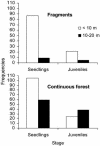Forest fragmentation severs mutualism between seed dispersers and an endemic African tree
- PMID: 14614145
- PMCID: PMC283544
- DOI: 10.1073/pnas.2331023100
Forest fragmentation severs mutualism between seed dispersers and an endemic African tree
Abstract
Because bird species are lost when forests are fragmented into small parcels, trees that depend on fruit-eating birds for seed dispersal may fail to recruit seedlings if dispersal agents disappear. We tested this prediction in rainforest in the East Usambara Mountains of Tanzania, by using the endemic tree Leptonychia usambarensis (Sterculiaceae) and birds that disperse its seeds. We investigated bird abundance and Leptonychia dispersal ecology in fragments isolated for >70 yr, as compared with 3,500 ha of continuous forest. Birds that dispersed Leptonychia seeds in continuous forest were rare or absent in small fragments, where fewer seeds were removed from each tree, far fewer seedlings occurred >10 m from parent trees, and far more seedlings occurred in dense aggregations under parental crowns. Overall, our samples showed that fewer juvenile Leptonychia recruited in fragments than in continuous forest. We provide solid evidence that deficient dispersal due to habitat fragmentation seriously impacts the reproductive cycle of a tropical bird-dispersed tree.
Figures



References
-
- MacArthur, R. H. & Wilson, E. O. (1967) The Theory of Island Biogeography (Princeton Univ. Press, Princeton).
-
- Laurance, W. F. (1997) in Tropical Forest Remnants: Ecology, Management, and Conservation of Fragmented Communities, eds. Laurance, W. F. & Bierregaard, R. O., Jr. (Univ. Chicago Press, Chicago), pp. 275–280.
-
- Preston, F. (1962) Ecology 43, 185–215.
-
- MacArthur, R. H. (1972) Geographical Ecology (Princeton Univ. Press, Princeton).
Publication types
MeSH terms
LinkOut - more resources
Full Text Sources

